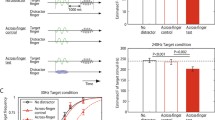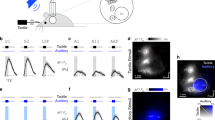Abstract
Certain sounds, such as fingernails screeching down a chalkboard, have a strong association with somatosensory percepts. In order to assess the influences of audition on somatosensory perception, three experiments measured how task-irrelevant auditory stimuli alter detection rates for near-threshold somatosensory stimuli. In Experiment 1, we showed that a simultaneous auditory stimulus increases sensitivity, but not response biases, to the detection of an electrical cutaneous stimulus delivered to the hand. Experiment 2 demonstrated that this enhancement of somatosensory perception is spatially specific—only monaural sounds on the same side increased detection. Experiment 3 revealed that the effects of audition on touch are also frequency dependent—only sounds with the same frequency as the vibrotactile frequency enhanced tactile detection. These results indicate that auditory information influences touch perception in highly systematic ways and suggest that similar coding mechanisms may underlie the processing of information from these different sensory modalities.



Similar content being viewed by others
References
Beauchamp MS, Ro T (2008) Neural substrates of sound–touch synesthesia after a thalamic lesion. J Neurosci 28:13696–13702
Bertelson P (1999) Ventriloquism: a case of cross modal perceptual grouping. In: Aschersleben G, Bachmann E, Müsseler J (eds) Cognitive contributions to the perception of spatial and temporal events. North-Holland, Elsevier Science Publishers, Amsterdam, pp 347–363
Bertelson P, Aschersleben G (1998) Automatic visual bias of perceived auditory location. Psychon Bull Rev 5:482–489
Bizley JK, Nodal FR, Bajo VM, Nelken I, King AJ (2007) Physiological and anatomical evidence for multisensory interactions in auditory cortex. Cereb Cortex 17:2172–2189
Clavagnier S, Falchier A, Kennedy H (2004) Long-distance feedback projections to area V1: implications for multisensory integration, spatial awareness, and visual consciousness. Cogn Affect Behav Neurosci 4:117–126
Driver J, Noesselt T (2008) Multisensory interplay reveals crossmodal influences on ‘sensory-specific’ brain regions, neural responses, and judgments. Neuron 57:11–23
Driver J, Spence C (1998a) Attention and the crossmodal construction of space. Trends Cogn Sci 2:254–262
Driver J, Spence C (1998b) Crossmodal attention. Curr Opin Neurobiol 8:245–253
Ernst MO, Banks MS, Bulthoff HH (2000) Touch can change visual slant perception. Nat Neurosci 3:69–73
Falchier A, Clavagnier S, Barone P, Kennedy H (2002) Anatomical evidence of multimodal integration in primate striate cortex. J Neurosci 22:5749–5759
Farne A, Ladavas E (2002) Auditory peripersonal space in humans. J Cogn Neurosci 14:1030–1043
Foxe JJ, Wylie GR, Martinez A, Schroeder CE, Javitt DC, Guilfoyle D, Ritter W, Murray MM (2002) Auditory-somatosensory multisensory processing in auditory association cortex: an fMRI study. J Neurophysiol 88:540–543
Gescheider GA, Barton WG, Bruce MR, Goldberg JH, Greenspan MJ (1969) Effects of simultaneous auditory stimulation on the detection of tactile stimuli. J Exp Psychol 81:120–125
Ghazanfar AA, Schroeder CE (2006) Is neocortex essentially multisensory? Trends Cogn Sci 10:278–285
Gillmeister H, Eimer M (2007) Tactile enhancement of auditory detection and perceived loudness. Brain Res 1160:58–68
Guest S, Catmur C, Lloyd D, Spence C (2002) Audiotactile interactions in roughness perception. Exp Brain Res 146:161–171
Halpern DL, Blake R, Hillenbrand J (1986) Psychoacoustics of a chilling sound. Percept Psychophys 39:77–80
Hotting K, Roder B (2004) Hearing cheats touch, but less in congenitally blind than in sighted individuals. Psychol Sci 15:60–64
Iguchi Y, Hoshi Y, Nemoto M, Taira M, Hashimoto I (2007) Co-activation of the secondary somatosensory and auditory cortices facilitates frequency discrimination of vibrotactile stimuli. Neuroscience 148:461–472
Johnson RM, Burton PC, Ro T (2006) Visually induced feelings of touch. Brain Res 1073–1074:398–406
Jousmaki V, Hari R (1998) Parchment-skin illusion: sound-biased touch. Curr Biol 8:R190
Kennett S, Taylor-Clarke M, Haggard P (2001) Noninformative vision improves the spatial resolution of touch in humans. Curr Biol 11:1188–1191
Macaluso E, Driver J (2005) Multisensory spatial interactions: a window onto functional integration in the human brain. Trends Neurosci 28:264–271
Navarra J, Soto-Faraco S, Spence C (2007) Adaptation to audiotactile asynchrony. Neurosci Lett 413:72–76
Occelli V, Spence C, Zampini M (2008) The effect of sound intensity on the audiotactile crossmodal dynamic capture effect. Exp Brain Res 193(3):409–419
Ozcan M, Baumgartner U, Vucurevic G, Stoeter P, Treede RD (2005) Spatial resolution of fMRI in the human parasylvian cortex: comparison of somatosensory and auditory activation. Neuroimage 25:877–887
Pavani F, Spence C, Driver J (2000) Visual capture of touch: out-of-the-body experiences with rubber gloves. Psychol Sci 11:353–359
Posner MI (1980) Orienting of attention. Q J Exp Psychol 32:3–25
Recanzone GH (1998) Rapidly induced auditory plasticity: the ventriloquism aftereffect. Proc Natl Acad Sci USA 95:869–875
Ro T, Wallace R, Hagedorn J, Farnè A, Pienkos E (2004) Visual enhancing of tactile perception in posterior parietal cortex. J Cogn Neurosci 16:24–30
Ro T, Farne A, Johnson RM, Wedeen V, Chu Z, Wang ZJ, Hunter JV, Beauchamp MS (2007) Feeling sounds after a thalamic lesion. Ann Neurol 62:433–441
Rock I, Victor J (1964) Vision and touch: an experimentally created conflict between the two senses. Science 143:594–596
Rock I, Mack A, Adams L, Hill AL (1965) Adaptation to contradictory information from vision and touch. Psychon Sci 3:435–436
Rockland KS, Ojima H (2003) Multisensory convergence in calcarine visual areas in macaque monkey. Int J Psychophysiol 50:19–26
Schroeder CE, Foxe J (2005) Multisensory contributions to low-level, ‘unisensory’ processing. Curr Opin Neurobiol 15:454–458
Schroeder CE, Lindsley RW, Specht C, Marcovici A, Smiley JF, Javitt DC (2001) Somatosensory input to auditory association cortex in the macaque monkey. J Neurophysiol 85:1322–1327
Schurmann M, Caetano G, Hlushchuk Y, Jousmaki V, Hari R (2006) Touch activates human auditory cortex. Neuroimage 30:1325–1331
Serino A, Bassolino M, Farne A, Ladavas E (2007) Extended multisensory space in blind cane users. Psychol Sci 18:642–648
Sherrick CE (1976) The antagonisms of hearing and touch. In: Hirsh SK, Eldredge DH, Hirsh IJ, Silverman SR (eds) Hearing and Davis: essays honoring Hallowell Davis. Washington University Press, St. Louis, MO, pp 149–158
Spence C, Driver J (1997) Audiovisual links in exogenous covert spatial orienting. Percept Psychophys 59:1–22
Spence C, Nicholls MER, Gillespie N, Driver J (1998) Cross-modal links in exogenous covert spatial orienting between touch, audition, and vision. Percept Psychophys 60:544–557
Stein B, Meredith M (1993) The merging of the senses. MIT Press, Cambridge, MA
Tipper SP, Lloyd D, Shorland B, Dancer C, Howard LA, McGlone F (1998) Vision influences tactile perception without proprioceptive orienting. Neuroreport: Int J Rapid Commun Res Neurosci 9:1741–1744
Tipper SP, Phillips N, Dancer C, Lloyd D, Howard LA, McGlone F (2001) Vision influences tactile perception at body sites that cannot be viewed directly. Exp Brain Res 139:160–167
Vroomen J, de Gelder B (2000) Sound enhances visual perception: cross-modal effects of auditory organization on vision. J Exp Psychol Hum Percept Perform 26:1583–1590
Zampini M, Torresan D, Spence C, Murray MM (2007) Auditory-somatosensory multisensory interactions in front and rear space. Neuropsychologia 45:1869–1877
Acknowledgments
TR designed the experiments; NY and MB made the tactile stimulators used in Experiment 3; TR, JH, NY, and LCE collected the data; TR, JH, NY, and LCE analyzed the data; TR wrote the manuscript. This research was supported in part by NSF Grants 0642801 (TR) and 0642532 (MB). These results were presented at the November, 2007 annual meeting of the Psychonomics Society, Long Beach, CA.
Author information
Authors and Affiliations
Corresponding author
Rights and permissions
About this article
Cite this article
Ro, T., Hsu, J., Yasar, N.E. et al. Sound enhances touch perception. Exp Brain Res 195, 135–143 (2009). https://doi.org/10.1007/s00221-009-1759-8
Received:
Accepted:
Published:
Issue Date:
DOI: https://doi.org/10.1007/s00221-009-1759-8




